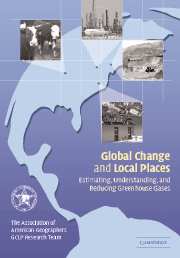Book contents
- Frontmatter
- Contents
- List of contributors
- Foreword
- Preface
- Acknowledgments
- Part One Global change and local places
- Part Two Learning from localities
- 3 Global change and Southwestern Kansas: local emissions and non-local determinants
- 4 Northwestern North Carolina: local diversity in an era of change
- 5 Northwestern Ohio: re-industrialization and emission reduction
- 6 Global change and Central Pennsylvania: local resources and impacts of mitigation
- Part Three Beyond Kyoto I: greenhouse gas reduction in local places
- Part Four Beyond Kyoto II: greenhouse gas reduction potentials and strategies
- Index
- References
4 - Northwestern North Carolina: local diversity in an era of change
Published online by Cambridge University Press: 31 July 2009
- Frontmatter
- Contents
- List of contributors
- Foreword
- Preface
- Acknowledgments
- Part One Global change and local places
- Part Two Learning from localities
- 3 Global change and Southwestern Kansas: local emissions and non-local determinants
- 4 Northwestern North Carolina: local diversity in an era of change
- 5 Northwestern Ohio: re-industrialization and emission reduction
- 6 Global change and Central Pennsylvania: local resources and impacts of mitigation
- Part Three Beyond Kyoto I: greenhouse gas reduction in local places
- Part Four Beyond Kyoto II: greenhouse gas reduction potentials and strategies
- Index
- References
Summary
Northwestern North Carolina offers a distinctive combination of economic development characteristic of the New South in the United States, extensive forest management, and intensive tourism. For project purposes, the region afforded opportunities to examine the effects of the population and affluence dimensions of the I = PAT+formulation, to consider the relative importance of forest carbon sinks in locality contributions to greenhouse gas emissions abatement, and to consider differences between local and statewide perspectives on greenhouse gas emission questions.
Greenhouse gas emissions in the Northwestern North Carolina study area originate primarily from a relatively small number of utility and industrial point sources, but affluence-related emissions from the transportation and residential sectors are also notable components of the region's mix of emissions sources. A surprisingly heavy reliance on local biomass waste by small manufacturing plants substitutes for the use of fossil fuels in the region, a facet of the global array of fuel and emissions issues perhaps evident in other forested regions.
Landscape, life, and livelihood
The study area covers parts of the Piedmont Plateau and Blue Ridge mountains with approximately two thirds lying in the Piedmont (Figure 2.2), a region characterized by rolling hills and gently sloping interfluves, with local relief typically less than 50 m (165 ft). The Blue Ridge portion of the study area is a heavily dissected mountainous region with most elevations lying between 900 and 1,500 m (2950–4925 ft) and with local relief often exceeding 300 m (985 ft).
- Type
- Chapter
- Information
- Global Change and Local PlacesEstimating, Understanding, and Reducing Greenhouse Gases, pp. 79 - 102Publisher: Cambridge University PressPrint publication year: 2003



